CalTestBed proudly announces its newest cohort of 12 clean-energy companies, pioneering research, and development around charging infrastructure, novel materials, grid monitoring, and more. These forward-thinking California-based startups were selected to receive vouchers that grant them access to world-class testing facilities at University of California laboratories to help them further test and validate their discoveries.
Funded by the California Energy Commission and operated by New Energy Nexus California, the CalTestBed initiative supports early-stage technologies by providing the necessary resources to refine and validate their groundbreaking solutions. The program’s commitment to equity and diversity in California’s clean energy transition is evident in its active recruitment of entrepreneurs from diverse backgrounds, including BIPOC, LGBTQ+, rural, and veteran communities (here are the specific CPUC designations). This focus ensures that the benefits of clean energy innovation extend to all Californians, particularly those in disadvantaged and low-income areas.
CalTestBed’s rigorous application and review process ensures that promising and impactful technologies receive support. Applicants undergo a comprehensive evaluation, considering their technologies’ innovation, feasibility, scalability, and potential impact.
The program focuses on diverse technology types, from renewable energy and energy storage to advanced materials and grid infrastructure. By partnering with leading UC laboratories, CalTestBed offers these companies opportunities to test and optimize their innovations in state-of-the-art facilities. This cohort showcases various technologies and applications, each contributing to California’s clean energy goal of reaching carbon neutrality by 2045. Learn more about the technologies CalTestBed supports and the program at CalTestBed.com.
Below, we highlight the innovative work and potential impact of these 12 companies, demonstrating why we chose them and where they will be testing their technologies.

Testbed: Lawrence Berkeley National Laboratories
Enventix, Inc. employs a patented thermocatalytic pyrolysis-reformer pathway to convert dry plant biomass waste into hydrogen, biofuel blend stock, biochar, and wood vinegar. This approach results in high conversion efficiency and flexibility in feedstock variability, producing multiple valuable products at a commercial scale of 230–460 tons per day while addressing energy security, sustainable farming, and carbon reduction.
Impact: Enventix’s technology has the potential to transform biomass waste into valuable products like biofuels and fertilizers, reducing the need for open burns and landfilling, improving local air quality, and lowering greenhouse gas emissions, with a carbon intensity range of -7 to -11 gCO2e/MJ.

Testbed: UC Davis
Flex Power Control‘s Smart Power Integrated Node (SPIN) is a Vehicle-to-Home (V2H) product providing a 10kW bidirectional charging system, expandable to 30kW, for whole-home backup using an electric vehicle.
This system integrates advanced power electronics to manage DC loads, including solar, stationary storage, and EVs, enabling both on-grid and off-grid operation. It can also island at home during power outages and export power to the grid upon request.
Impact: The SPIN product uses the growing number of EV batteries as a new category of Distributed Energy Resources (DERs), helping to stabilize the electric grid during peak demand. Its unique bidirectional charging capability using the Combined Charging Standard (CCS) sets it apart from other products, making it a valuable asset for grid resilience and energy management.

Testbed: Lawrence Berkeley National Laboratories
EvolOH is developing a cost-effective, scalable water electrolyzer stack using anion exchange membranes (AEM) that rely on earth-abundant materials like steel and plastic, avoiding the need for rare earth elements. This innovative approach enables high-volume manufacturing of electrolyzers with 100% domestic supply chains, achieving significant cost reductions and efficiency improvements in green hydrogen production, with proven performance benchmarks in efficiency, current density, and durability.
Impact: EvolOH’s low-cost electrolyzers can produce green hydrogen more affordably than current technologies, offering substantial savings compared to battery storage for long-term renewable energy storage. This transition to green hydrogen could save California approximately $80 million annually and significantly reduce CO2 and NOx emissions, aiding in decarbonizing the state’s energy and transportation sectors.

Testbed: UC Riverside
Evolectric is creating a hardware and software solution for retrofitting existing combustion engine commercial vehicles with new battery-electric powertrains. This innovative approach leverages AC-based overnight charging, reducing thermal impact and GHG emissions while enhancing vehicle efficiency and longevity. Evolectric offers a cost-effective and scalable pathway to transition commercial fleets to zero-emission vehicles by using modular software and hardware for retrofitting.
Impact: By reusing existing vehicle chassis, Evolectric lowers the economic and environmental costs of manufacturing new electric vehicles. Their retrofit kits, produced in California, enable rapid deployment and scalability, offering a faster and more cost-effective solution for fleet owners, especially small and medium-sized businesses, to transition to electric vehicles.

Testbed: UC Irvine
Kfobix invented a lightweight, low-cost, and durable superhydrophobic nano-composite coating called K-FobiX. This innovative coating can be easily applied via airbrush or drone to prevent ice formation on power lines and wind turbines, enhancing electrical distribution safety and renewable energy efficiency. The nanocomposite achieves superhydrophobic properties without fluorinated chemicals, maintains light transmittance of around 80%, and lasts up to four years.
Impact: K-FobiX has the potential to significantly reduce maintenance costs for energy transmission lines by 24.2% and prevent ice buildup on wind turbines, improving their efficiency and performance. This leads to lower operational costs and increased reliability of renewable energy infrastructure, aligning with California’s commitment to environmental sustainability.

Testbed: Lawrence Berkeley National lab
Twelve is pioneering a scalable electrolyzer technology that converts carbon dioxide into essential building blocks for chemicals and fuels. The initial focus is sustainable aviation fuel (SAF) produced through the Fischer-Tropsch process from electrolyzed carbon monoxide. Twelve is constructing a groundbreaking CO2-to-SAF plant, with their SAF certified for up to a 50% blend in jet engines under ASTM D7566 Annex A1. The project aims to enhance the performance and durability of the membrane electrode assembly, the electrolyzer’s core component. Twelve’s electrolyzer can efficiently utilize excess electricity, promoting renewable energy’s economic viability and reducing overall electricity costs.
Impact: Twelve’s SAF offers significant environmental advantages, including 80% less fine particulate matter and over 90% less ozone than petroleum jet fuel. Additionally, SAF emits less NOx and SOx, benefiting residents near California airports, often low-income communities. Deploying this technology at scale could reduce CO2 emissions by 2-3 billion tons annually, mitigating climate change impacts such as wildfires and flooding.

Testbed: UC Riverside
Relyion Energy is pioneering an advanced energy storage system that utilizes repurposed electric vehicle (EV) batteries, extending their lifecycle and minimizing environmental waste. Their prototype integrates second-life EV batteries into a scalable system, enhanced by advanced control algorithms and machine learning for optimized performance. The system provides a sustainable and cost-effective solution for energy storage, crucial for supporting the transition to renewable energy and the electrification of transportation while promoting a circular economy by minimizing battery waste.
Impact: Relyion’s energy storage system significantly reduces upfront capital expenditures for energy storage by 30-50% compared to first-life battery systems. This cost-effectiveness, combined with extended battery life and improved performance, leads to long-term savings. Reduced strain on California’s electricity grid during peak times translates into lower energy costs for ratepayers, benefiting commercial and industrial users and underserved communities.

Testbed: UC San Diego
UNIGRID is advancing a sodium-ion 18650 cylindrical cell, a standardized battery form factor widely used in the industry. This innovation competes with lithium-ion (Li-ion) 18650s, offering a safer, more cost-effective energy storage solution. The sodium-ion battery addresses key challenges associated with current technologies, including cost, safety, and material supply chain issues. By leveraging low-cost, abundant, and domestically sourced sodium materials, UNIGRID’s battery reduces the bill of materials by 50% compared to lithium-ion batteries while being non-flammable and releasing no toxic fumes.
Impact: The advanced sodium-ion battery offers superior performance metrics, including lower cost, improved safety, a wider operating temperature range, and higher energy densities than lithium-ion and lead-acid batteries, ensuring more reliable and efficient energy storage.

Testbed: UC San Diego
Tyfast‘s innovation is a high-performance lithium-ion battery that replaces conventional graphite with a proprietary vanadium-based anode. This technology allows for ten times faster charging (under six minutes), ten times the cycle life (over 10,000 cycles), new charging capability below freezing temperatures (as low as -40°C), and enhanced safety due to the metal oxide anode. Tyfast designed the battery to meet the rigorous demands of heavy-duty and construction vehicles, providing continuous high power and reliability in challenging conditions.
Impact: The batteries’ enhanced safety features, including non-flammability and resistance to lithium-metal plating, lower the risk of battery fires and toxic fume emissions. These improved safety features are crucial for heavy-duty and construction vehicles operating near residential areas, reducing health hazards for communities and workers.

Testbed: UC Davis
Nelumbo‘s innovation involves advanced surface treatments for heat exchangers in residential heat pumps, enhancing resistance to frost formation and accelerating frost shedding. This technology increases the operational efficiency of heat pumps, particularly in frosty conditions, by extending operating time and reducing defrost cycles. Additionally, Nelumbo’s surfaces enable the use of more efficient heat transfer designs that are otherwise prone to performance degradation due to frost, thereby supporting the transition of 14.5 million homes in California from natural gas furnaces to heat pumps.
Impact: Nelumbo’s technology can save over 2 billion kWh annually by transitioning electric resistance heaters to heat pumps three to four times more efficiently than traditional heaters. The significant energy saving from this technology helps reduce electricity consumption and peak load demand, contributing to a more resilient and efficient power grid in California.

Testbed: UC Riverside
The GridSweep instrument is an advanced hardware technology integrated with firmware and software that enhances grid reliability, efficiency, and solar deployment capacity. It measures the stability of distribution grids with inverter-based resources like solar power inverters and battery storage inverters. GridSweep uses a subsynchronously modulated electric heater to probe a 120-volt outlet while measuring voltage changes at a different location on the grid, providing parts-per-billion resolution. This technology increases the hosting capacity for solar generation resources, enabling more solar power deployment without grid replacement or upgrades.
Impact: By identifying faults and ignition points early, GridSweep can contribute to wildfire prevention and overall grid safety. Its precise measurement capabilities and low-cost deployment make it a valuable tool for enhancing the safety of California’s electricity grid, especially in areas prone to wildfires.

Testbed: UC Riverside
ChargePodX is developing a charging technology that provides a Level 3 DC Fast Charging experience using existing Level 2 (240V AC) infrastructure. This portable design eliminates the need for extensive construction of fixed charging stations, offering a flexible and efficient charging solution. ChargePodX’s portable DC-fast chargers can be easily deployed in various locations, ensuring accessibility in underserved regions and urban areas without complex installations.
Impact: ChargePodX’s portable DC fast chargers enable rapid deployment in diverse locations, bridging the gap in areas lacking permanent charging infrastructure. Portable fast chargers increase accessibility and convenience for EV owners, particularly in underserved and urban regions, encouraging wider adoption of electric vehicles and supporting California’s goal of increasing EV usage.
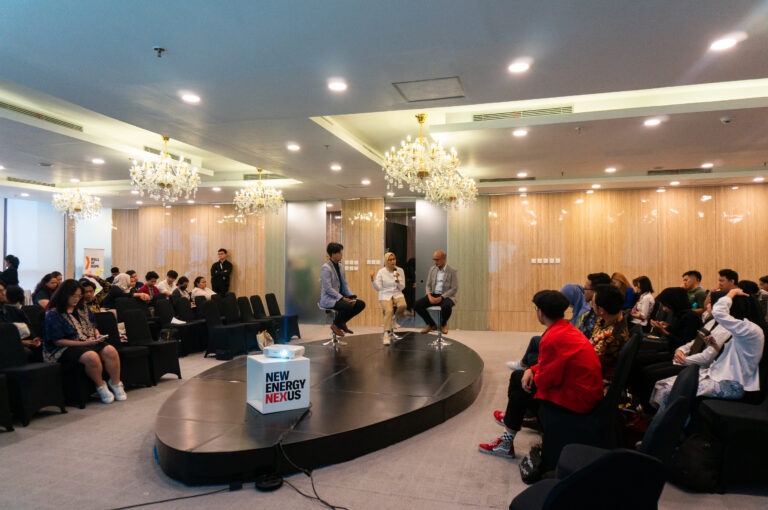
Participants of the [RE]Power Launch event listen to a discussion on Indonesia’s energy policy and the role of young people in shaping the country’s sustainable energy future.
The climate crisis is not some distant issue, but an immediate challenge that disproportionately affects us: the youth. We are the ones who will live with the consequences of today’s policy decisions. Therefore, we must understand how these energy policies are crafted and their potential impacts—both positive and negative. Youth is crucial in identifying new solutions to the challenges our world urgently needs to address.
This is why New Energy Nexus Indonesia initiated Indonesia’s first youth-driven energy policy hackathon, [RE]Power. The event is more than just a gathering; it provides a unique platform for young people to engage with complex issues, learn from experts, and collaborate on innovative solutions. It’s a space where youth can voice their concerns and actively participate in crafting policies that will shape their future. Beyond the event itself, policy hackathons symbolize a broader movement toward making youth participation in policy-making, especially in the energy sector, more meaningful.
At the Policy Hackathon, we are bringing together a diverse group of individuals with varying perspectives and expertise, such as tech, engineering, law, and management, among others. This diversity is key for the group to think outside their own boxes, and be able to bring something new to the national energy policy front. When people from different backgrounds and skill sets collaborate, they are more likely to come up with creative solutions and see gaps that a more homogenous group might overlook. In the context of clean energy and climate policy, this means drawing on insights from young engineers, social scientists, environmentalists, and even those who simply have a passion for sustainability. Furthermore, diversity is essential to the development of inclusive policies that can address the multifaceted challenges of our time, without leaving anyone behind.
Moreover, these events create a sense of community and shared purpose. Young participants not only learn from experts but also from each other, building networks that can be leveraged for future initiatives. This collaborative spirit is crucial for fostering a culture of continuous improvement in clean energy policy.
One of the biggest challenges young people face in engaging with policy is the lack of transparency and access to information. Often, policy-making processes are not as transparent, making it difficult for the youth to understand how decisions are made and how such decisions can influence their lives. By contrast, policy hackathons provide a transparent and inclusive environment where young people can learn about policy frameworks, regulatory processes, and the complexities of governance. These offer hands-on experience that is invaluable for anyone looking to make a real impact.
Beyond the event itself, policy hackathons symbolize a broader movement toward making youth participation in policy-making more meaningful. Involving youth in these processes means we have to equip them with the knowledge and skills needed to be effective participants. Through educational programs, mentorship opportunities, and platforms for dialogue, we can empower young people, especially the ones who have just begun their careers and considering being involved in governance. They become not just passive recipients of policy decisions, but active shapers of them and preparing them to be future energy leaders.
At New Energy Nexus Indonesia, we believe that empowering youth with the knowledge and tools to engage in policy-making is essential for a sustainable future. This is why we’re hosting Indonesia’s first youth-driven policy hackathon—it’s an opportunity for young Indonesians to step up, put their minds into action, and lead the charge towards a cleaner, more sustainable future. By bringing together diverse groups, fostering innovation, and providing transparent, accessible information, we can ensure that today’s youth are not just prepared for the future—they are the ones deciding what it should look like.

Enda Grimonia is the Policy Analyst Manager at New Energy Nexus Indonesia. Before joining NEX Indonesia, she served as the Head of the Renewable Energy Division at the Laboratory of Energy and Environmental Engineering at the Department of Engineering Physics, Sepuluh Nopember Institute of Technology (ITS), and as the Head of Competency Development at the Society of Renewable Energy ITS, the largest youth-led renewable energy organization in East Java, Indonesia.

Speakers at the ConNEX Workshop: Securing Working Capital & Advanced Financial Planning
On July 25, 2024, we hosted a virtual workshop on Advanced Financial Planning, attended by entrepreneurs from all over California and as far as Ethiopia. The event provided insights into the unique financial landscape for clean energy startups and featured the following speakers:
Harris delved into the shifting landscape of clean energy funding. She highlighted the necessity for startups to communicate their intrinsic value beyond their technology and look for additional revenue and collateral options. Harris discussed blending public and private capital to transition projects from the research phase to viable businesses.
Harris also highlighted the importance of doing product market fit work before the product is ready. She encouraged entrepreneurs to ask:
“Who’s started to think about earmarking money for the specific problem you’re solving, and if they haven’t done that yet, how do you get them to?”
Scott Pitts shared insights on creative funding solutions, emphasizing the importance of finding financing partners who are open to innovative approaches. He provided the example of how his financing partner bought equipment and resold it to the startup, using collateral to secure more funding. Pitts discussed the need for high-fidelity cash flow forecasts and building strong relationships within the industry – before needing to ask for money.
“If you only manage your business based on the money you have in the bank, you have a capacity issue,” explained Pitts. He encouraged leveraging incubators and local venture/angel groups to find supporters passionate about clean energy.
“Find lovers with money.”
He urged entrepreneurs to find people who are excited about their technology and have the resources to invest.
Davis encouraged founders to use SAFE notes (Simply Agreement for Future Equity) using the Y-combinator template. She stressed the importance of securing non-dilutive capital quickly and bridging funding gaps with loans. Davis highlighted the significance of maintaining well-organized financial records and building a robust pro forma. She encouraged companies seeking early-stage financing to visit Enduring Planet’s website and apply.
The session concluded with strategic advice for startups. Pitts emphasized the importance of having a backup plan and advised being prepared for potential capital crunches. Harris encouraged treating regulatory requirements as drivers of innovation and leveraging networks to increase funding access.
Funders & Accelerators
Grant Writing
Recruiting
Financial Management
Special thanks to our partner, Momentum, and funder, The California Energy Commission.
How did we do? Please take a short survey to help us improve this workshop series.
July 31, 2024 – New Energy Nexus is expanding its impact into Pakistan through a partnership with Renewables First, the country’s leading think tank for energy and the environment.

From left: Zeeshan Ashfaq, CEO of Renewables First, and Stanley Ng, Global Partnerships Director at New Energy Nexus
The partnership, announced at the Pakistan Cleantech Forum in Islamabad, will set the stage for economic growth, job creation, and increased international investment in Pakistan’s burgeoning climate tech sector.
Recognizing Pakistan’s climate vulnerability and substantial climate financing gap, the partnership aims to catalyze change in the climate tech space by combining New Energy Nexus’s global expertise in accelerating clean energy businesses and startups with Renewables First’s deep understanding of local challenges. This collaboration comes at a pivotal moment, as Pakistan strives to meet its ambitious Paris Agreement commitment of reducing emissions by 50% by 2030.
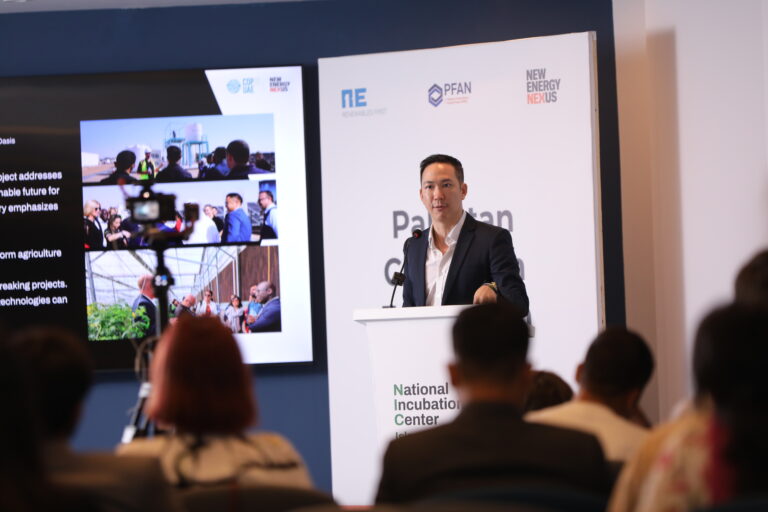
Stanley Ng, Global Partnerships Director at New Energy Nexus
“Our partnership with New Energy Nexus marks a significant milestone in Renewables First’s mission of accelerating Pakistan’s energy transition,” said Zeeshan Ashfaq, CEO of Renewables First.
“Pakistan presents an ideal market for cleantech growth, where potential is aplenty, and our youth deserves opportunities to flourish and mainstream their ideas. We remain committed to investing in the future of Pakistan’s cleantech ecosystem.”
Stanley Ng, Global Partnerships Director at New Energy Nexus, said: “Pakistan is the world’s fifth most populous nation, with its largest industries in high carbon-emitting sectors like textiles, agriculture, automotive, cement, steel, and chemicals. Here lies an immense opportunity to ignite the development of groundbreaking climate tech innovations.
“New Energy Nexus, with its vast experience in ecosystem building, and Renewables First, with its deep energy market insights and network, are coming together to unlock this potential. Together, we will identify critical areas where climate entrepreneurs can craft impactful solutions, deploy them, and scale their efforts to enable a low-carbon economy.”
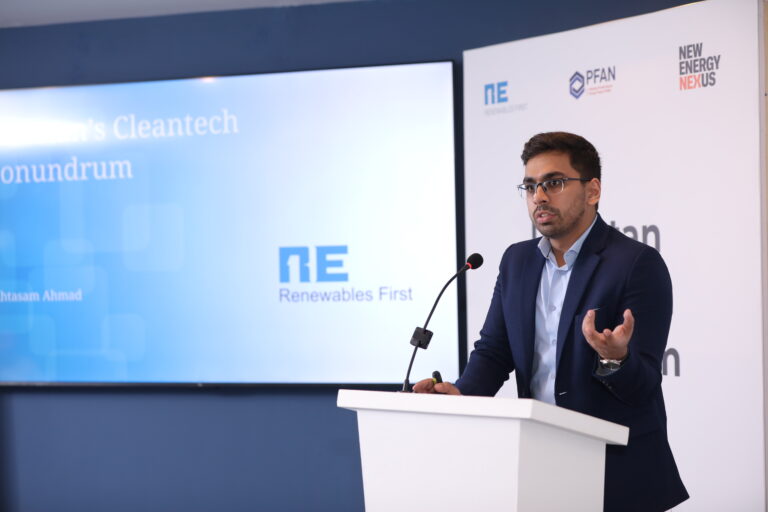
Ahtasam Ahmad, Energy Finance Associate at Renewables First
New Energy Nexus and Renewables First will launch programs in the next 12 months focusing on developing a strong pipeline of clean energy startups and enhancing their success through tailored training programs, as well as collaboration with other ecosystem stakeholders and policy advocacy to support an enabling environment for climate tech innovation.
About Renewables First
Renewables First (RF) is a think-and-do tank for energy and the environment. RF’s work addresses critical energy and natural resource issues with the aim of making energy and climate transitions just and inclusive through impactful research, advocacy, and strategic partnerships. More at: www.renewablesfirst.org
Tristan Tremschnig
Global Communications Director, New Energy Nexus
tristan.tremschnig@newenergynexus.com
(based in San Francisco)
Komal Tariq
Manager Learning & Communications, Renewables First
komal.tariq@renewablesfirst.org
(based in Islamabad)
About New Energy Nexus
New Energy Nexus (NEX) is an international organization that strives towards a 100% clean energy economy for 100% of the population. It does this with a laser focus on diverse entrepreneurs, supporting them with accelerators, funds, skills, and networks they need to thrive. NEX has accelerated 1,500+ startups, empowered over 10,400+ entrepreneurs, and mobilized over US$4.7 billion in investment. Since its founding in California in 2004, NEX now operates programs or advisory services in Australia, China, India, Indonesia, Nigeria, Pakistan, the Philippines, Thailand, the UAE, Uganda, the USA (California and New York), and Vietnam.
Jakarta, Indonesia, July 18 – New Energy Nexus Indonesia has signed a memorandum of understanding (MoU) with the Directorate General of Small and Medium Industries, Ministry of Industry of the Republic of Indonesia, to partner on a program that will empower clean technology entrepreneurs in the country to scale.
The MoU signing, officiated by Dr. Agus Gumiwang Kartasasmita, M.Si, Minister of Industry of the Republic of Indonesia, is for a Clean Technology Startup Development Program, which will focus on the development, capacity-building, and promotion of cleantech startups.
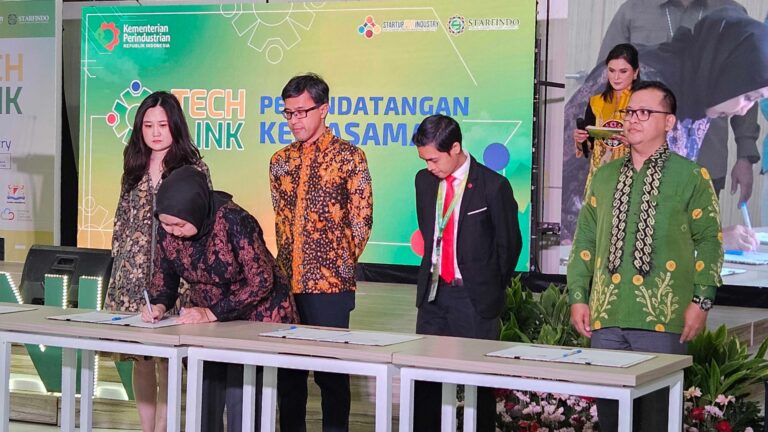
NEX ID signing an MoU with the Directorate General of Small and Medium Industries, Ministry of Industry of the Republic of Indonesia, officiated by Minister of Industry Dr. Agus Gumiwang Kartasasmita, M.Si.
Diyanto Imam, Program Director of New Energy Nexus Indonesia, said the partnership is an “honor,” and will significantly contribute to the growth and success of the emerging cleantech space in the country.
“This partnership will provide invaluable support to clean technology startups, empowering them to thrive through comprehensive training, mentorship, and market opportunities – enabling more innovative minds to catalyze cleantech solutions,” he said.
The program will include training, workshops, and certification assistance for The Domestic Component Level (Tingkat Komponen Dalam Negeri/TKDN). Obtaining TKDN certification will increase startups’ visibility and enable them to join the Indonesian government’s e-catalog, which allows the government to be an early adopter of the startups’ products.
Through services such as business matchmaking and integration with the Directorate’s programs, NEX ID will also provide cleantech startups access to a broader market of industries eager to transition into green, eco-friendly operations. These startups will serve as crucial tools, assisting industries in their conversion to sustainable practices.
The partnership will run for two years, during which time NEX ID hopes to foster innovation in the cleantech industry and contribute to a sustainable future—in Indonesia and beyond. To learn more about opportunities for Indonesian startups, check out our website.
About New Energy Nexus Indonesia
In Indonesia, New Energy Nexus works to support the development of ecosystems that can support the needs of not only innovators, startups, and entrepreneurs, but also other stakeholders in the clean energy and climate solutions sectors.
Raisha Fatya
Communications Manager, New Energy Nexus Indonesia
raisha.fatya@newenergynexus.com
About New Energy Nexus
New Energy Nexus (NEX) is an international organization that strives towards a 100% clean energy economy for 100% of the population. It does this with a laser focus on diverse entrepreneurs, supporting them with accelerators, funds, skills, and networks they need to thrive. NEX has accelerated 1,500+ startups, empowered over 10,400+ entrepreneurs, and mobilized over US$4.7 billion in investment. Since its founding in California in 2004, NEX now operates programs or advisory services in Australia, China, India, Indonesia, Nigeria, Pakistan, the Philippines, Thailand, the UAE, Uganda, the USA (California and New York), and Vietnam.
July 16, 2024 – New Energy Nexus announces today the appointment of Jie Xiao as the new General Manager of China. Jie succeeds Andrew Chang, who has been promoted to Chief Growth Officer in the global team.
In 2016, Andrew launched New Energy Nexus’ operations in China and under his leadership, the team built accelerators, incubation and advisory services for clean energy startups and initiated commercial partnerships with key ecosystem partners such as Energy Internet and Research Institute, Tsinghua University (EIRI) and LG Energy Solutions. His relentless efforts empowered startups, driving their success and established New Energy Nexus as a key player in China’s clean energy innovation space.

Jie Xiao, New Energy Nexus China’s new General Manager.
As the new General Manager of China, Jie Xiao brings a wealth of experience in the environmental, social and governance (“ESG”) and innovation sector.
“I am excited to lead our team in China and expand our partnerships with key players across China’s clean energy landscape. Together, we’ll advance New Energy Nexus’ mission of empowering clean energy entrepreneurs and implementing our ‘China In, China Out’ strategy,” said Jie Xiao.
Jie Xiao began her career in finance and banking for multinational corporations, and later served as Secretary-General for the Shanghai United Foundation, founding CEO of Brilliance Camp, and Chief Growth Officer for CBi China. With over a decade of leadership experience, Jie excels in maximizing ESG outcomes through innovative partnerships and navigating complex landscapes.
“Jie Xiao brings a diverse and inclusive perspective that is crucial for our continued impact in addressing climate change. With her at the helm, I am excited to take on the new role of Chief Growth Officer and contribute to our global strategy, particularly in exploring new international opportunities,” said Andrew Chang.
“New Energy Nexus’ first operations outside of California started in China, and since then Andrew has taken the chapter from strength to strength. His drive and strategic vision will be critical in his new role, as we look to expand our impact in new markets, and build new partnerships around the world,” said Danny Kennedy, CEO at New Energy Nexus.
“With Jie’s international perspective and unique set of skills across the sustainability and innovation sector, I am confident in our continued growth and impact in China – a country that is the very engine of the global clean energy transition.”
Tristan Tremschnig
Global Communications Director, New Energy Nexus
tristan.tremschnig@newenergynexus.com
(based in San Francisco)
Jasper Shen
Marketing Director, New Energy Nexus China
jasper.shen@newenergynexus.com
(based in Shanghai)
About New Energy Nexus
New Energy Nexus (NEX) is an international organization that strives towards a 100% clean energy economy for 100% of the population. It does this with a laser focus on diverse entrepreneurs, supporting them with accelerators, funds, skills, and networks they need to thrive. NEX has accelerated 1,500+ startups, empowered over 10,400+ entrepreneurs, and mobilized over US$4.7 billion in investment. Since its founding in California in 2004, NEX now operates programs or advisory services in Australia, China, India, Indonesia, Nigeria, Pakistan, the Philippines, Thailand, the UAE, Uganda, the USA (California and New York), and Vietnam.
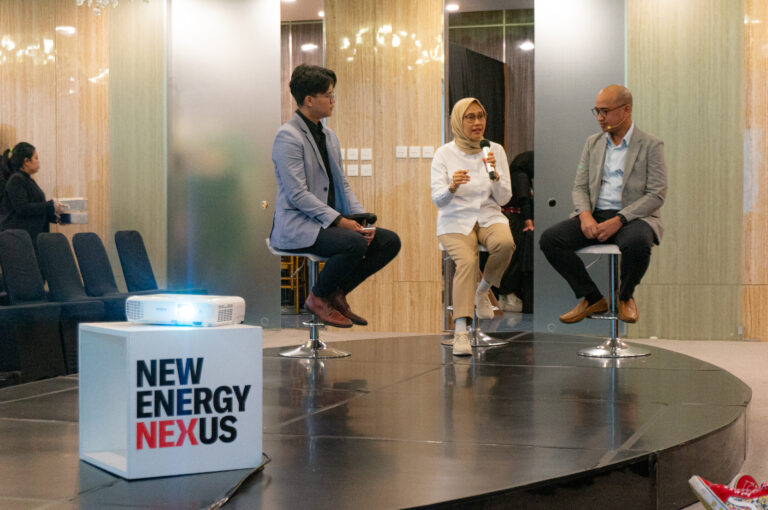
From left: Mujab (Founder, Generasi Perintis), Sripeni Inten Cahyani (Expert Staff for the Minister of Energy and Mineral Resources), and Mulya Amri (Faculty Chair, Golkar Institute) discuss Indonesia’s energy policy and the role of young people in shaping the country’s sustainable energy future.
Jakarta, 15 July 2024 – New Energy Nexus (NEX) Indonesia is today launching [RE]Power, Indonesia’s first youth-driven energy policy hackathon. The initiative convenes the next generation of Indonesian policymakers and thinkers to accelerate the development of future-proof policies for the country’s clean energy transition.
“The [RE]Power Policy Hackathon is a platform where young minds can engage with real-world energy challenges. It also represents a significant step in empowering Indonesia’s youth to actively participate in shaping our energy policies,” said Diyanto Imam, Program Director at New Energy Nexus Indonesia.
“By bringing together aspiring policymakers and experienced mentors, we aim to spark innovative ideas that will shape Indonesia’s sustainable energy landscape. We’re eager to see the creative and impactful solutions that will emerge from this initiative.”
As the first youth-driven policy hackathon, the program focuses on empowering young people through an innovative approach that actively engages them in energy policy. Participants will delve into critical topics in the clean energy space, such as financing and investment, planning and roadmap making, research and development, infrastructure and technology, and public-private partnerships.
They will also benefit from mentorship, networking opportunities with policymakers and experts, and have the chance to win a total prize of IDR 45,000,000 (US$2,780). Participants will also have the opportunity to present their policy recommendations at the final pitch day in September.
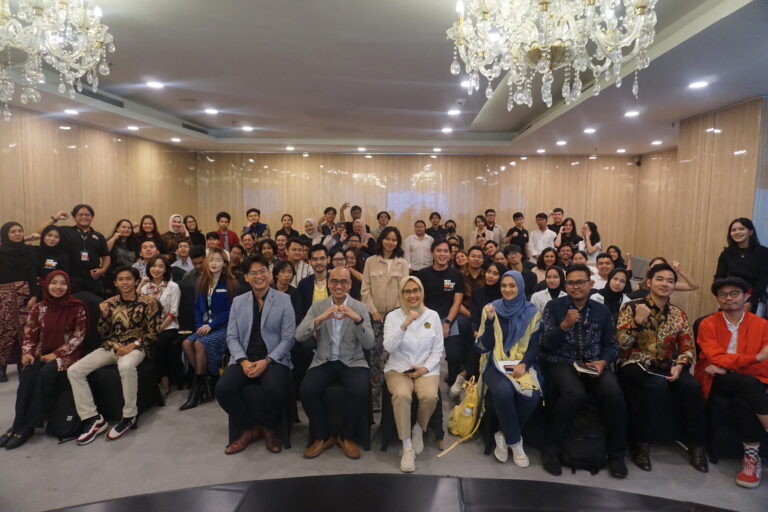
Mujab (Founder, Generasi Perintis), Sripeni Inten Cahyani (Expert Staff for the Minister of Energy and Mineral Resources), and Mulya Amri (Faculty Chair, Golkar Institute) sit with attendees of the [RE]Power Policy Hackathon launch.
Sripeni Inten Cahyani, Expert Staff for the Minister of Energy and Mineral Resources, said: “The [RE]Power Policy Hackathon represents a powerful opportunity for Indonesia’s youth to contribute to a sustainable and inclusive energy future, By empowering young leaders to engage in policy-making and innovation, we are ensuring that diverse voices and perspectives are included in the decision-making process, and we are honored to support this initiative:”
The hackathon is the highlight of six sub-national workshops NEX Indonesia has organized in 2024. With over 260 applicants across the first four workshops, it is evident that the youth are eager to shape Indonesia’s future energy policies. This hackathon serves as an ideal platform for them to kickstart their journey in the energy policy sector.
NEX Indonesia is proud to partner with over 10 youth-led communities such as BEM FH Universitas Indonesia, Climate Rangers Jakarta, Economy for Ecology, Environmental Law Society Fakultas Hukum Universitas Indonesia, Green Welfare Indonesia, School of STEM Universitas Prasetya Mulya, Society of Renewable Energy Institut Teknologi Bandung, Society of Renewable Energy Institut Teknologi Kalimantan, Society of Renewable Energy Universitas Indonesia & Teens Go Green Indonesia, whose instrumental support has sparked exciting discussions and engagement. The support from Bappenas and KESDM has also been pivotal in ensuring the success of this initiative.
Applications are open until August 15th, 2024 to Indonesian youth aged 18-24 who are dedicated to clean energy and climate solutions. Those interested can apply here.
Selected photos here.
About New Energy Nexus Indonesia
In Indonesia, New Energy Nexus works to support the development of ecosystems that can support the needs of not only innovators, startups, and entrepreneurs, but also other stakeholders in the clean energy and climate solutions sectors.
Raisha Fatya
Communications Manager, New Energy Nexus Indonesia
raisha.fatya@newenergynexus.com
About New Energy Nexus
New Energy Nexus (NEX) is an international organization that strives towards a 100% clean energy economy for 100% of the population. It does this with a laser focus on diverse entrepreneurs, supporting them with accelerators, funds, skills, and networks they need to thrive. NEX has accelerated 1,500+ startups, empowered over 10,400+ entrepreneurs, and mobilized over US$4.7 billion in investment. Since its founding in California in 2004, NEX now operates programs or advisory services in Australia, China, India, Indonesia, Nigeria, Pakistan, the Philippines, Thailand, the UAE, Uganda, the USA (California and New York), and Vietnam.
The Decarbonize Thailand Symposium we co-hosted with True Digital Park is one of the year’s most significant clean energy meetings in Thailand. It’s also a unique opportunity to showcase local global climate tech startups, and build partnerships with some of the country’s biggest corporations.
Now in its second year, we teamed up with Denso and Mitsubishi Thailand to focus on four arenas: e-mobility, decarbonization, agritech, and energy.
New Energy Nexus showcased over 20 startups at the symposium, with an additional 37 expressing interest from both Thailand and abroad, spanning countries like India, Japan, the Philippines, and Singapore. Here are a few of them…
Algal Bio is revolutionizing industries with their ‘Algae Biofoundry Platform’. Their tech licensing service unlocks the power of algae, identifying top strains and cultivation methods for everything from wellness to carbon neutralization.
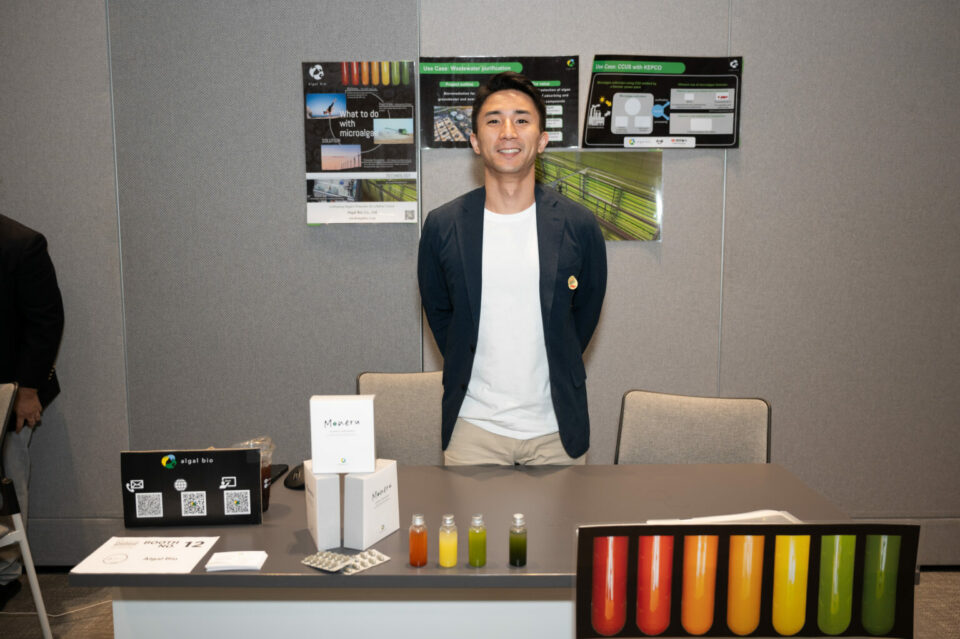
Masahiro Kida, Team Leader for International Business Development, Algal Bio
Gideon’s platform offers complete carbon accounting and energy trading capabilities, making it easy for SMEs and non-technical users to track and trade carbon emissions. Specializing in scalable, emission tracking, and simulation digital platforms, they’re leading the way towards a greener future.
Chosen Digital is leading the charge in future energy innovation. Partnering with PEA, they’re pioneering the next-gen energy landscape with cutting-edge EV charging and beyond. From energy trading to virtual power plants, they’re transforming the game with plans for regional expansion.

Worapoj Ruenrerngwong, Founder & CEO, Chosen Group
Multi Energy Decarbonized Solutions (MEDS) is unlocking sustainable energy solutions. As leaders in scalable energy modeling, they harness cutting-edge platforms, empowering businesses with actionable strategies to offset and slash carbon emissions, driving sustainable operations forward.
Alternō Air is revolutionizing green energy with sand batteries! Their Thermal Energy Storage (TES) system is changing the game, offering efficient and eco-friendly energy storage for zero-emission heating in agriculture and industry.
“For the last 20 years, we have supported 1,200 companies working in this energy and climate space across 13 different countries. Our mission is to build hundreds of companies in each country, helping our industry leaders to decarbonize their businesses.”
–Stanley Ng, Global Partnerships Director at New Energy Nexus.
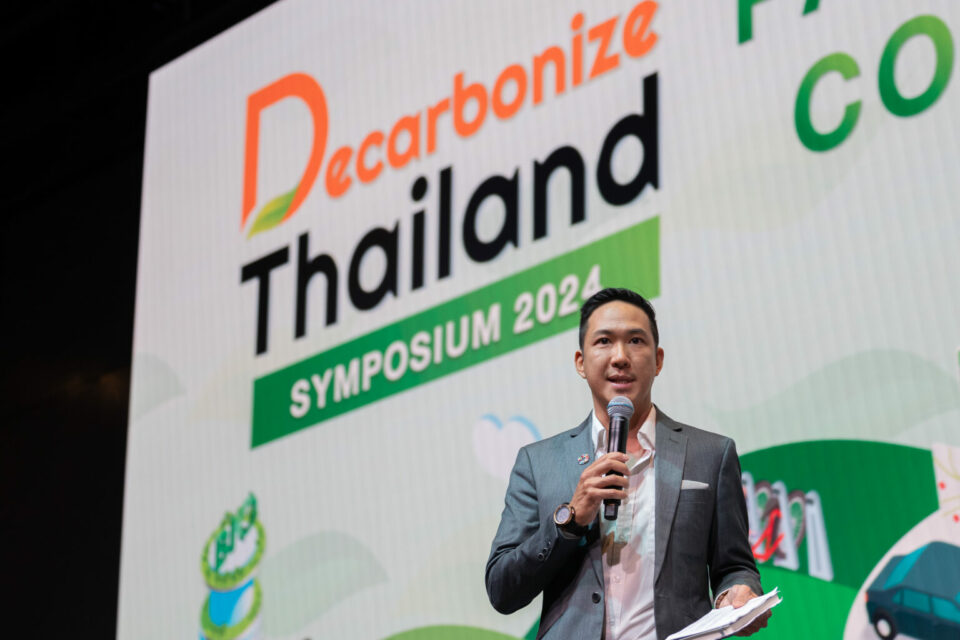
Stanley Ng, Global Partnerships Director at New Energy Nexus
New Energy Nexus Thailand has supported clean energy innovators since 2017, and fostered a thriving ecosystem for startup teams dedicated to tackling rising energy demands and climate change. Our programs empower entrepreneurs to drive innovation in the clean energy sector, with corporate partnership a critical strategy to decarbonising the broader economy.
Learn more about NEX Thailand and check out our climate tech ecosystem mapping report.
Sydney, 16 May 2024 – The second annual Supercharge Australia Innovation Challenge, “Retrofit Nation”, is launching today in Sydney during Climate Action Week. The Challenge is calling on startups to rapidly convert half the Australian vehicle fleet to electric vehicles (EVs), which is over 10 million vehicles.
One of the immediately viable opportunities lies in retrofitting existing heavy vehicles with lithium batteries to support the move to an electric vehicle fleet. In 2022 the transport sector contributed to 19% of Australia’s emissions. Trucks, buses and light commercial vehicles account for about 40% of the total transport figure and the industry comprises a relatively small group of decision makers that can accelerate change.
A recent report from Beyond Zero Emissions shows that battery technologies are emerging as one of the most promising sectors for Australia’s economic growth and decarbonisation efforts, potentially creating up to 20,000 jobs and AU$114 billion revenue by 2035.
The Challenge is open to startups, entrepreneurs, scientists and researchers are to develop and present solutions to questions such as:
Startups receive prizes, support, networking and mentoring to accelerate their success.
“Transport is an obvious target for reform, particularly in Australia with our reliance on road freight and use of mining vehicles. We need to encourage the supply of more EV’s sooner into the Australian and global markets. Putting electric motors and batteries into existing vehicles at scale and massively increasing Australian battery demand is a sure-fire and fast-track way of getting it done,” said Danny Kennedy, CEO New Energy Nexus.
“The mass EV retrofit opportunity can help to upskill the Australian workforce including electricians, mechanics, software developers with critical skills in advanced manufacturing, batteries and EV’s – essential for our economy in the future. The Supercharge Australia Innovation Challenge will unleash innovation from the startup community and capture ideas that show how we can make this mass EV retrofit opportunity a reality,” said Megan Fisher, CEO EnergyLab.
“Australia produces half of the world’s lithium yet retains less than 1% of the value it produces. We can’t just keep sending our lithium offshore where others capture its value. It’s time we change this, together,” said Kirk McDonald, Project Manager Supercharge Australia.
“We’d need AU$181 billion worth of batteries to retrofit half the Australian vehicle fleet, or 20x our current near term forecast demand to 2030. This quantity would de-risk and incentivise lithium battery and cell production in Australia, in the best case using our world-class renewable energy resources.
“So, in support of the Prime Minister’s ‘Future Made in Australia’ initiative, there’s even broader advanced battery manufacturing ecosystem advantages as reasons to proceed and we look forward to seeing the innovative solutions that we know Australian startups are so good at.”
Participants in the inaugural Supercharge Australia Innovation Challenge raised over AU$40 million in funding subsequent to the first challenge. The second Supercharge Australia Innovation Challenge will uncover more opportunities for rapid support and growth for Australian solutions.
The second annual Supercharge Australia Innovation Challenge, “Retrofit Nation”, will launch on Thursday 16 May at 3pm (AEST) at EnergyLab Sydney: 4-12 Buckland St, Chippendale NSW 2008, Australia. Journalists are welcome to attend.
Kirk McDonald
Project Manager Supercharge Australia
kirk.mcdonald@newenergynexus.com
+61 412 336 848
Tristan Tremschnig
Global Communications Director tristan.tremschnig@newenergynexus.com (based in San Francisco)
About New Energy Nexus
New Energy Nexus (NEX) is an international organization that strives towards a 100% clean energy economy for 100% of the population. It does this with a laser focus on diverse entrepreneurs, supporting them with accelerators, funds, skills, and networks they need to thrive. NEX has accelerated 1,500+ startups, empowered over 10,400+ entrepreneurs, and mobilized over US$4.7 billion in investment. Since its founding in California in 2004, NEX now operates programs or advisory services in Australia, China, India, Indonesia, Nigeria, Pakistan, the Philippines, Thailand, the UAE, Uganda, the USA (California and New York), and Vietnam.